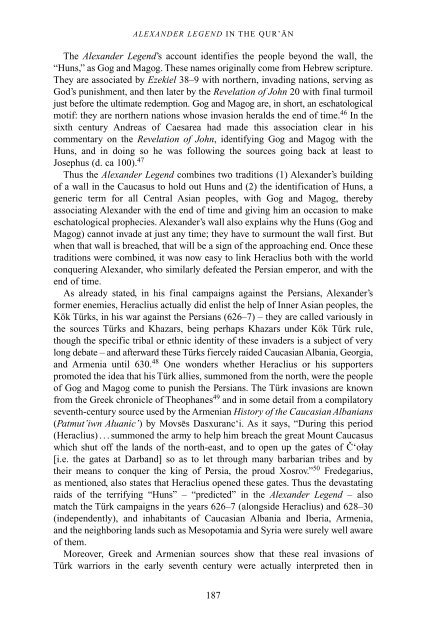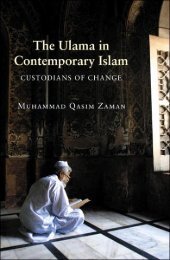The Qur'an in its historical context (pdf - Islam and Christian-Muslim ...
The Qur'an in its historical context (pdf - Islam and Christian-Muslim ...
The Qur'an in its historical context (pdf - Islam and Christian-Muslim ...
You also want an ePaper? Increase the reach of your titles
YUMPU automatically turns print PDFs into web optimized ePapers that Google loves.
ALEXANDER LEGEND IN THE QUR’AN<br />
<strong>The</strong> Alex<strong>and</strong>er Legend’s account identifies the people beyond the wall, the<br />
“Huns,” as Gog <strong>and</strong> Magog. <strong>The</strong>se names orig<strong>in</strong>ally come from Hebrew scripture.<br />
<strong>The</strong>y are associated by Ezekiel 38–9 with northern, <strong>in</strong>vad<strong>in</strong>g nations, serv<strong>in</strong>g as<br />
God’s punishment, <strong>and</strong> then later by the Revelation of John 20 with f<strong>in</strong>al turmoil<br />
just before the ultimate redemption. Gog <strong>and</strong> Magog are, <strong>in</strong> short, an eschatological<br />
motif: they are northern nations whose <strong>in</strong>vasion heralds the end of time. 46 In the<br />
sixth century Andreas of Caesarea had made this association clear <strong>in</strong> his<br />
commentary on the Revelation of John, identify<strong>in</strong>g Gog <strong>and</strong> Magog with the<br />
Huns, <strong>and</strong> <strong>in</strong> do<strong>in</strong>g so he was follow<strong>in</strong>g the sources go<strong>in</strong>g back at least to<br />
Josephus (d. ca 100). 47<br />
Thus the Alex<strong>and</strong>er Legend comb<strong>in</strong>es two traditions (1) Alex<strong>and</strong>er’s build<strong>in</strong>g<br />
of a wall <strong>in</strong> the Caucasus to hold out Huns <strong>and</strong> (2) the identification of Huns, a<br />
generic term for all Central Asian peoples, with Gog <strong>and</strong> Magog, thereby<br />
associat<strong>in</strong>g Alex<strong>and</strong>er with the end of time <strong>and</strong> giv<strong>in</strong>g him an occasion to make<br />
eschatological prophecies. Alex<strong>and</strong>er’s wall also expla<strong>in</strong>s why the Huns (Gog <strong>and</strong><br />
Magog) cannot <strong>in</strong>vade at just any time; they have to surmount the wall first. But<br />
when that wall is breached, that will be a sign of the approach<strong>in</strong>g end. Once these<br />
traditions were comb<strong>in</strong>ed, it was now easy to l<strong>in</strong>k Heraclius both with the world<br />
conquer<strong>in</strong>g Alex<strong>and</strong>er, who similarly defeated the Persian emperor, <strong>and</strong> with the<br />
end of time.<br />
As already stated, <strong>in</strong> his f<strong>in</strong>al campaigns aga<strong>in</strong>st the Persians, Alex<strong>and</strong>er’s<br />
former enemies, Heraclius actually did enlist the help of Inner Asian peoples, the<br />
Kök Türks, <strong>in</strong> his war aga<strong>in</strong>st the Persians (626–7) – they are called variously <strong>in</strong><br />
the sources Türks <strong>and</strong> Khazars, be<strong>in</strong>g perhaps Khazars under Kök Türk rule,<br />
though the specific tribal or ethnic identity of these <strong>in</strong>vaders is a subject of very<br />
long debate – <strong>and</strong> afterward these Türks fiercely raided Caucasian Albania, Georgia,<br />
<strong>and</strong> Armenia until 630. 48 One wonders whether Heraclius or his supporters<br />
promoted the idea that his Türk allies, summoned from the north, were the people<br />
of Gog <strong>and</strong> Magog come to punish the Persians. <strong>The</strong> Türk <strong>in</strong>vasions are known<br />
from the Greek chronicle of <strong>The</strong>ophanes 49 <strong>and</strong> <strong>in</strong> some detail from a compilatory<br />
seventh-century source used by the Armenian History of the Caucasian Albanians<br />
(Patmut’iwn A„uanic’) by Movses Dasxuranc‘i. As it says, “Dur<strong>in</strong>g this period<br />
(Heraclius)...summoned the army to help him breach the great Mount Caucasus<br />
which shut off the l<strong>and</strong>s of the north-east, <strong>and</strong> to open up the gates of #‘o„ay<br />
[i.e. the gates at Darb<strong>and</strong>] so as to let through many barbarian tribes <strong>and</strong> by<br />
their means to conquer the k<strong>in</strong>g of Persia, the proud Xosrov.” 50 Fredegarius,<br />
as mentioned, also states that Heraclius opened these gates. Thus the devastat<strong>in</strong>g<br />
raids of the terrify<strong>in</strong>g “Huns” – “predicted” <strong>in</strong> the Alex<strong>and</strong>er Legend – also<br />
match the Türk campaigns <strong>in</strong> the years 626–7 (alongside Heraclius) <strong>and</strong> 628–30<br />
(<strong>in</strong>dependently), <strong>and</strong> <strong>in</strong>habitants of Caucasian Albania <strong>and</strong> Iberia, Armenia,<br />
<strong>and</strong> the neighbor<strong>in</strong>g l<strong>and</strong>s such as Mesopotamia <strong>and</strong> Syria were surely well aware<br />
of them.<br />
Moreover, Greek <strong>and</strong> Armenian sources show that these real <strong>in</strong>vasions of<br />
Türk warriors <strong>in</strong> the early seventh century were actually <strong>in</strong>terpreted then <strong>in</strong><br />
187



